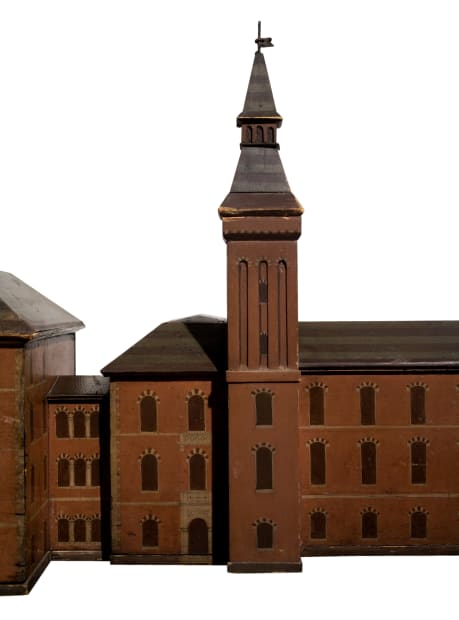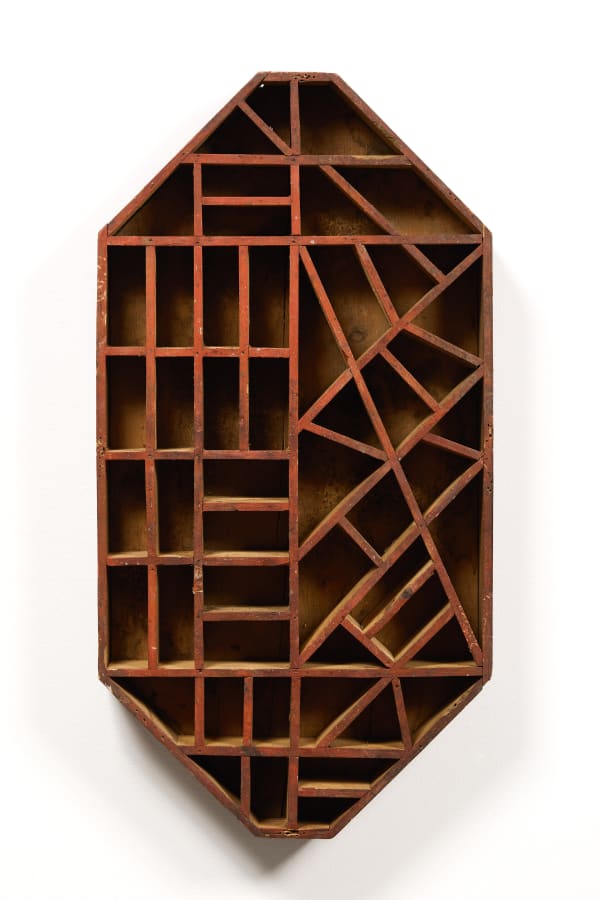There is a singular resonance in things made without pretense—forms shaped by instinct, devotion, necessity, or play. American Vernacular: Art and Objects by Unknown Artists brings together a wide-ranging constellation of works that lie outside the boundaries of canonical art history. They were not created for galleries or museums, and many were never meant to be preserved. And yet, they endure as objects of magic and mystery.
This exhibition assembles utilitarian objects, ritualistic forms, and spontaneous sculptures that speak fluently in the language of the handmade. At its center is a 1912 flag salesman’s sampler printed on buckram—an arresting graphic that presents thirteen standardized versions of the 48-star American flag in a visual crescendo of patriotism, design, and commerce. A monumental anthracite carving, hewn from solid coal, features a relief of a nude figure on one face, expressive carved faces on two others, and what appears to be a stylized tree or organic motif on the fourth—a compact monument to labor, sensuality, and imaginative form. Alongside these: a powerful glazed ceramic snake; an iconic voting booth curtain painted in the colors of the American flag; an exquisitely complex Tramp Art box fashioned from notched cigar wood; and an architect’s model of a Rhode Island hospital dated 1863. These objects were formed not by academic theory, but by the haptic intelligence of the hand. Their makers are mostly unknown, but the objects themselves speak volumes.
Ricco/Maresca has long championed the expressive force of the vernacular. Since our founding in the 1980s, we have sought to elevate works that exist beyond formal instruction, beyond the codified metrics of cultural value. This exhibition continues that mission—rooted in our first sculpture book, American Primitive: Discoveries in Folk Sculpture (Knopf, 1988), and furthered by American Vernacular: New Discoveries in Folk, Self-Taught, and Outsider Sculpture (Knopf, 2002). It also draws from the lineage of past exhibitions such as Chance (1991–92), which explored the aesthetic potential of found objects, and Formed with Function (2023), a celebration of utilitarian design’s unintended elegance.
American Vernacular broadens the scope even further. While some works in the exhibition were clearly conceived with utilitarian purpose—a mathematics counting board, a railroad car spring—others resist easy classification. Take the Draped Nude, a small polychromed clay sculpture from the 1940s, intimate in scale and disarmingly direct in presence. Or the assembled specimen collector box, which may once have housed the curiosities of a backyard naturalist. Then there is the double-sided carnival photo cutout—depicting a boxer on one side and Superman on the other—originally designed for fairgoers to insert their faces and momentarily inhabit these heroic figures. Stripped of context and reframed by time, it now registers as both sculptural artifact and a poignant relic of American humor, fantasy, and collective play.
The power of these works lies, in part, in their ambiguity. They resist tidy interpretation. They were not made to conform to critical discourse or market trends, and yet they elicit recognition. The forged iron owl from the 1940s is both whimsical and totemic. The Forms for Learning Parliamentary Procedure, printed on cardboard, carry the earnest absurdity of didactic design. The carved wooden relief of a woman emerges gently from its board, as if coaxed into visibility by time itself.
As we define it, the American vernacular encompasses the functional and the poetic, the devotional and the accidental, the humorous and the haunting. It is a category shaped not by doctrine but by attention—by the willingness to see what others might pass by. What emerges here is a chorus of individual visions. Every scratch, notch, and brushstroke is an answer to a question felt but never spoken. In a time that often privileges authorship over authenticity, American Vernacular highlights the fact that the most meaningful forms of creativity are often those least acknowledged—and that, at its core, true expression rarely asks for permission; it simply asks to be seen.
-
-

-
-
-
 Railroad Car Spring (Probably American Steel & Wire Co., Worcester, MA), ca. 1920sPainted steel. A similar example is currently on display at MoMA (Floor 5, The David Geffen Wing)27 1/4 x 15 1/2 in. (69.2 x 39.4 cm)(FM Personal 313)
Railroad Car Spring (Probably American Steel & Wire Co., Worcester, MA), ca. 1920sPainted steel. A similar example is currently on display at MoMA (Floor 5, The David Geffen Wing)27 1/4 x 15 1/2 in. (69.2 x 39.4 cm)(FM Personal 313) -
 Stylized Human / Heart Form - Possibly a Former Utilitarian Object, late 19th centuryCast iron (custom wall mount)26 x 11 x 1 in. (66 x 27.9 x 2.5 cm)(ArU 510)SOLD
Stylized Human / Heart Form - Possibly a Former Utilitarian Object, late 19th centuryCast iron (custom wall mount)26 x 11 x 1 in. (66 x 27.9 x 2.5 cm)(ArU 510)SOLD
-
-
Concurrently on view in Gallery Two:
Thornton Dial: A Gift
Visit the online viewing room here.


































